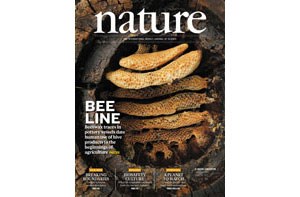I - 34151 Trieste Italy
(+39) 040 2240 111
pio@ictp.it

13/11/2015 - Trieste
A unique, multidisciplinary research team at ICTP has had not one, but two papers published this week in prominent science journals, highlighting the successful mix of archeology, paleontology and physics happening in the Centre's Multidisciplinary Laboratory (MLab).
One paper, published in Nature and featured on its cover, reveals a map of where Neolithic farmers exploited bee products across Europe and Northern Africa. The second paper, which appears in PlosOne, investigates fossilized fish vomit and announces the revision of a twenty-five year old paleotologic finding.
"The paper in Nature is a clear example of interdisciplinary collaboration, because you have chemical analysis applied to archeology," says ICTP researcher Federico Bernardini, an archeologist by training. The paper announces the results of a large effort to analyze shards of Neolithic pottery scattered between Northern Africa and Northern Europe. The residues on all of these ancient cooking pots were subjected to chemical analysis, looking for evidence of bee products. The paper, titled 'Widespread exploitation of the honeybee by early Neolithic farmers' (doi:10.1038/nature15757), maps not only the use of beeswax and honey by Neolithic people but also where the honeybee lived more than 9,000 years ago, information that is missing from any fossil record.
The PlosOne paper also proves how fruitful the MLab's collaborations can be. Just over 200 million years ago, a large fish ate a small creature and then vomited. The fossil of that vomit was found in Northern Italy, containing many tiny bone fragments that were originally identified as belonging to a type of pterosaur, a flying reptile. When it was found and first investigated in 1989, there was no way to examine the inside of the fossil without breaking it. Using the MLab's microCT scanner, a non-invasive device that can produce extremely detailed 3D images, ICTP researcher Claudio Tuniz and colleagues were able to give paleontologists much more information about the shapes of the bone shards. The information led paleontologists to revise their earlier decision, announcing that the fish had likely eaten a protorosaurus, a slender, quick lizard that was decidedly terrestrial. The resulting paper is titled 'A reappraisal of the purported gastric pellet with pterosaurian bones from the Upper Triassic of Italy' (doi:10.1371/journal.pone.0141275)
It is thanks to physicists that tools such as microCT scanners are available to look at fossils and archaeological artifacts. "The physicist gives the eyes to the paleontologist," says Tuniz. A physicist by training, Tuniz designs experiments and employs tools that are both novel and quite useful to archeologists, paleontologists and paleoanthropologists.
ICTP's microCT scanner, the physics tool at the centre of these investigations, was set up in collaboration with Elettra Sincrotrone Trieste. It uses x-rays to take cross-sectional images of an object, images that can later be manipulated to produce three dimensional simulations of both the inside and the outside of the sample. "It's like the CT scan in the hospital, only it has hundreds of times better resolution, down to six thousandths of a millimeter," explains Tuniz. MicroCTs themselves are not uncommon; the tool is routinely used in medicine and industry. But ICTP's microCT is one of only a handful that was built specifically to study cultural history and paleontology in a non-invasive way, and remains dedicated to analyzing ancient bones, teeth and pottery, among other samples.
Additional tools in the MLab give researchers further clues about their artifact samples. Bernardini, who specializes in using these new tools to best effect, explains. "X-ray fluorescence and x-ray diffraction analysis is important to get the chemical and mineralogical composition of the sample." While these are not new technologies, the tools at ICTP are distinct for their compact construction, precision, and combination of several types of analyses, Bernardini explains. "Sometimes the combination of both kinds [chemical and structural] of information are critical to solve different kinds of problems."
"The interdisciplinary nature of the MLab is also quite important," Bernardini continues. "It is quite strange to have physicists, archaeologists and paleoanthropologists working together." But that is the niche the MLab and its tools were designed for. A large amount of information can be collected about samples in the lab without causing any damage, a priority for conservationists. From fragile pottery and tiny fossils to dinosaur teeth and pre-human skulls, the physicist-built equipment has given archeologists and paleoanthropologists a powerful set of tools.
"If you want to have interesting and important results, you really have to build bridges between different disciplines," says Bernardini. There is no shortage of scientists across a wide range of fields who want to collaborate with Tuniz and Bernardini, both internationally and locally. Samples are brought and mailed from all over the world for analysis in the lab, in addition to the trove provided through collaborations with regional museums. For both Tuniz and Bernardini, it is clear the ICTP MLab is uniquely placed to study questions, from human evolution to Roman ruins, that can help investigate and preserve cultural and ecological heritage from all corners of the globe.
--Kelsey Calhoun
NOTE: Research for the two papers is the product of ICTP collaboration with Trieste scientific institutions Elettra and the Museum of Natural History of Trieste and Udine. ICTP Mlab instruments are the outcome of cooperation with Sincrotrone Trieste, using funding from the Regione Friuli Venezia Giulia.